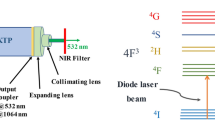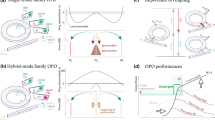Abstract
We report the amplification of a low-power 4-mW microchip Nd:YVO4 laser at 1064 nm, passively Q-switched with a semiconductor saturable absorber mirror (SESAM). An end-pumped two-stage amplifier module with small-signal gain of 56 dB has been designed to boost the power, generating 6 W at 550 kHz with 100-ps pulses and M 2 = 1.2. Second-harmonic generation in critically phase-matched LBO yielded 3 W at 532 nm, with pulse stability comparable to that of the fundamental frequency.
Similar content being viewed by others
Avoid common mistakes on your manuscript.
1 Introduction
Powerful, multiwatt 1-μm laser sources of sub-nanosecond pulses are frequently requested for particularly demanding material processing applications as well as for high-power frequency conversion. Compact diode-pumped minilasers [1, 2], or even microchip oscillators [3–5], can achieve ~0.5–1 ns pulse duration at repetition rates up to few tens of kilohertz usually with passive Q-switching employing Cr:YAG saturable absorbers.
However, sometimes shorter pulses and much higher repetition rates are preferred. These allow faster material processing and reduced thermal affected zones. Microchip lasers employing a semiconductor saturable absorber mirror (SESAM) directly bonded to a thin Nd:YVO4 crystal are very promising, generating pulses as short as 35 ps [6], but even more conservative designs yielding ~100 ps pulses at hundreds of kilohertz are extremely attractive. In a recent report [7], one of such microchip lasers was amplified with a large-mode-area (LMA) photonics crystal fiber to 3.4 W at 200 kHz, with significant spectrum broadening that was eventually exploited for pulse compression to 6 ps.
Traditional diode-pumped solid-state amplifier can also be used for many applications since these are generally less expensive than special LMA fibers, and in addition the beam area can be tailored to minimize self-phase-modulation or other undesirable effects such as stimulated scatterings. We report here a diode-pumped amplifier that produces 6 W at 550 kHz when seeded by a 4-mW microchip, with diffraction-limited and nearly Fourier-limited pulses of 100 ps duration. The amplifier was designed with a high-gain first stage and a high-extraction-efficiency second stage, and was pumped by 40 W total power. This design is readily scalable up to several tens of watts at 1064 nm.
2 Experiments
The microchip laser was a 150-μm Nd:YVO4 crystal bonded to a SESAM [8]. It generates pulses of ~100 ps at a repetition rate that varies linearly with the input pump power (Fig. 1a).
a Microchip laser seeder. SML single-mode laser diode; C1, C2 cylindrical beam expander (×8) for beam circularization; L1 8-mm focal aspheric collimator; L2 50-mm focal singlet; DM dichroic mirrors, HR/HT at 1064/808 nm. b Amplifier setup. FI faraday isolator; L3 200-mm focal lens; L4 300-mm focal lens; PO1, PO2 pump imaging optics for the fiber-coupled laser diodes (×1 and ×1.4 magnification, respectively)
We chose a single-mode 200-mW laser diode (Intense Ltd.) at 808 nm as the pump source. The intrinsic higher stability of the narrow emission spectrum (~0.05 nm) yielded the best performance as compared with the other pump sources we previously investigated, such as a 50-μm core fiber-coupled 0.5-W laser diode and a space-coupled 1-W laser diode. Also, the narrower spectrum yields the highest gain per unit power, with the same pump spot size of 2w = 40 μm, resulting in the lowest laser threshold.
With 140-mW pump power incident on the microchip laser, we measured a clean TEM00 output beam with up to 4 mW at 550 kHz. The laser optical spectrum corresponds to single-frequency operation (free spectral range = 1.7 nm, about twice the Nd:YVO4 fluorescence bandwidth [9]), with center wavelength that could be tuned over ~ 0.1 nm by slightly deviating the pump beam axis from normal incidence. This allows a fine tuning with the fluorescence spectrum of the diode-pumped amplifier. The microchip was mounted in a thermally controlled holder.
The amplifier module (Fig. 1b) employed a first high-gain, double-pass stage with a 0.5 % doped 5-mm long Nd:YVO4 crystal pumped by a 15-W fiber-coupled laser diode at 808 nm. The crystal was 1° wedge and the pump face was coated to obtain high transmissivity at 808 nm and high reflectivity at 1064 nm, whereas the opposite face was antireflection coated at 1064 nm. The fiber-coupled laser diode was focussed to a spot diameter 2w = 200 μm, and the absorbed pump was 11 W. Using a cw vanadate laser for preliminary characterization, we measured small-signal gain of 2900 and saturation power of 315 mW. The laser seeder was focussed into the amplifier at a small reflection angle of ~1.5° to exploit the high gain of the pumped volume in double-pass.
The second stage was a 10-mm long 0.2 % doped Nd:YVO4 crystal, coated to obtain high transmission at 1064 and 808 nm, pumped by a 25-W fiber-coupled laser diode at 808 nm. The pump beam was focussed to a spot diameter 2w = 280 μm and the absorbed fraction was 76 %. The small-signal gain was 137 and the saturation power was 2.2 W. The total small-signal gain of the amplifier was therefore G0 = 3.97 × 105 = 56 dB. Extraction efficiency as high as 47.3 % was measured with 2 W input in this second amplifier module, yielding 11 W out of 19 W absorbed pump power in a nice TEM00 beam.
When the microchip laser was employed as the seeder, protected by a Faraday isolator that transmitted 3.5 mW, the amplified power after the first stage was ∼ 650 mW, and up to 6 W was measured at the output of the second stage, corresponding to a single pulse energy of 11 μJ at 550 kHz.
The output beam quality parameter was measured to be M 2 = 1.2, nearly the same as that of the seeder, and the output power was stable to within ±0.5 % rms (Fig. 2). A snapshot of the amplified pulse train is shown in Fig. 3.
We measured the pulse width with a fast 6-GHz oscilloscope (Tektronix TDS6604B) and fast fiber-coupled photodetector (Thorlabs SIR5-FC, 70-ps pulse response fwhm), as well as with a 175-ps scanning range type-I second-harmonic autocorrelator (Femtochrome FR-103XL). The oscilloscope measured ∼ 110–140 ps (fwhm) depending on the alignment of the focussed signal into the optical fiber, showing that the pulse width was clearly close to the instrumental resolution, while the autocorrelation yielded slightly shorter pulses of 100 ps (Fig. 4), that did not change in duration decreasing the pump power of the amplifier.
The optical spectrum measured with a spectrum analyzer Yokogawa ANDO AQ6317B (15 pm resolution) was 33 pm fwhm, yielding a time bandwidth product ∼ 0.78, close to the Fourier limit for a gaussian pulse (0.41). Since the single pulse is clearly single-longitudinal-mode, it is possible that a small wavelength drift contributes to the actual pulse bandwidth measurement.
We also performed a simple test of second-harmonic generation (SHG) in angle-phase-matched lithium triborate (LBO), given the rather high 110-kW pulse peak power which did not require strong focussing. The beam was focussed to a spot diameter 2w = 200 μm into the 15-mm LBO crystal, with a corresponding intensity of ~500 MW/cm2, producing 3 W at 532 nm with a perfectly round spot and no appreciable angular walk-off. This SHG test proved a very good stability and efficiency and was useful to confirm the significant pulse stability and the very low ASE interpulse background of the laser system. As shown in Fig. 2b, the second-harmonic fluctuations increased only to 1 % rms, very likely due to the slow temperature drift of the LBO, as well as to the small frequency jitter of the passive Q-switching.
Stopping the seeder, we detected ~50 mW of amplified spontaneous emission (ASE) out of the amplifier module. Given the saturated gain G ~ 1.7 × 103 and the small-signal gain G 0 ~ 4 × 105, the ASE power emitted within the output beam solid angle should reduce by a factor [10]
therefore, we expect an ASE background <1 mW on the amplified pulse train.
Indeed, we could not detect such sub-mW interpulse level when looking at the fast oscilloscope screen and switching the seeder on/off. Also, we could not detect appreciable differences in SHG efficiency from pump depletion at the oscilloscope and from direct power meter measurements.
3 Conclusions
We have demonstrated a microchip laser pumped by a single-mode 200-mW laser diode, the pump source with lowest power employed to date for such picosecond devices. It generated ~100-ps pulses at 550 kHz with 4-mW output power, that was effectively amplified to 6 W with a two-stage end-pumped Nd:YVO4 amplifier module, with an optical-to-optical efficiency of 20 % and single pulse energy of 11 μJ. Further power scaling is possible by increasing the pump power of the second stage, or by adding another stage designed for maximum extraction. Indeed, we have demonstrated that the second stage could already amplify at ~50 % efficiency when injected with sufficiently high power of 2 W, extracting 9 W: for example, an upscaled version of such stage would produce ~33 W total output from 6 W input, with ~60 W absorbed pump power. Lower doping levels and larger pump spot areas should be chosen to minimize parasitic effects such as energy transfer upconversion. Of course, the increased total gain would present a more serious challenge on ASE suppression, hence devices such as resonant saturable absorbers should be possibly employed, with no significant penalty on the total efficiency with the pulse train at hundreds of kHz [11]. It is quite clear that these lasers could be very attractive for many industrial applications, especially for micromachining. The advantage of the end-pumped Nd:YVO4 amplifier over the apparently simpler “grazing incidence” setup [12] is clearly due to symmetric pump spot size and much easier thermal lens management. The large-mode size allows easier power scaling than with optical fibers amplifiers, where expensive and not always off-the-shelf special LMA photonic fibers or rods should be chosen.
References
J. Dong, K. Ueda, A. Shirakawa, H. Yagi, T. Yanagitani, A. Kaminskii, Composite Yb:YAG/Cr4+:YAG ceramics picosecond microchip lasers. Opt. Express 15, 14516 (2007)
A. Agnesi, P. Dallocchio, F. Pirzio, G. Reali, Sub-nanosecond single-frequency 10-kHz diode-pumped MOPA laser. Appl. Phys. B 98, 737–741 (2010)
J.J. Zayhowski, C. Dill III, Diode-pumped passively Q-switched picosecond microchip lasers. Opt. Lett. 19, 1427–1429 (1994)
J.J. Zayhowski, Periodically poled lithium niobate optical parametric amplifiers pumped by high-power passively Q-switched microchip lasers. Opt. Lett. 22, 169–171 (1997)
F. Druon, F. Balembois, P. Georges, A. Brun, High-repetition-rate 300-ps pulsed ultraviolet source with a passively Q-switched microchip laser and a multipass amplifier. Opt. Lett. 24, 499–501 (1999)
G.J. Spühler, R. Paschotta, R. Fluck, B. Braun, M. Moser, G. Zhang, E. Gini, U. Keller, Experimentally confirmed design guidelines for passively Q switched microchip lasers using semiconductor saturable absorbers. J. Opt. Soc. Am. B 16, 376–388 (1999)
A. Steinmetz, T. Eidam, D. Nodop, J. Limpert, A. Tünnermann, Nonlinear compression of Q-Switched laser pulses to the realm of ultrashort durations. Opt. Express 19, 3758–3764 (2011)
BATOP GmbH, www.batop.de
J.J. Zayhowski, J. Harrison, in Handbook of Photonics, Chapter. 8, ed. by M. C. Gupta, CRC Press (1997)
W. Koechner, Solid-state laser engineering, Springer (1999)
A. Agnesi, L. Carrà, P. Dallocchio, F. Pirzio, G. Reali, S. Lodo, G. Piccinno, 50-mJ macro-pulses at 1064 nm from a diode-pumped picosecond laser system. Opt. Express 19, 20316–20321 (2011)
A. Agnesi, L. Carrà, F. Pirzio, G. Reali, A. Tomaselli, D. Scarpa, C. Vacchi, Amplification of a low-power picosecond Nd:YVO4 laser by a diode-laser side-pumped grazing-incidence slab amplifier. IEEE J. Quantum Electron 42, 772–776 (2006)
Acknowledgments
This research was sponsored by Bright Solutions Srl.
Author information
Authors and Affiliations
Corresponding author
Rights and permissions
About this article
Cite this article
Agnesi, A., Carrà, L., Pirzio, F. et al. Low-power 100-ps microchip laser amplified by a two-stage Nd:YVO4 amplifier module. Appl. Phys. B 109, 659–662 (2012). https://doi.org/10.1007/s00340-012-5234-z
Received:
Revised:
Published:
Issue Date:
DOI: https://doi.org/10.1007/s00340-012-5234-z








